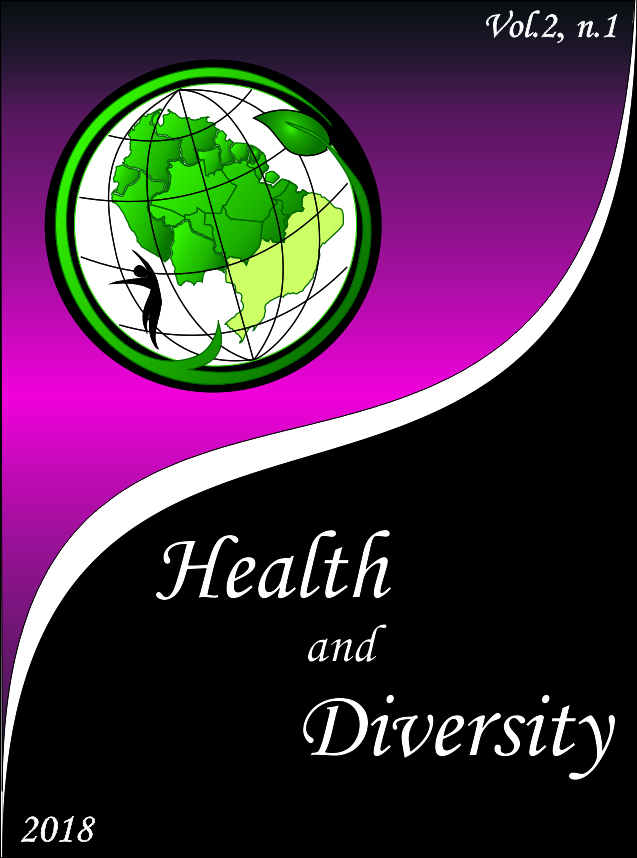Syphilis: a serious problem of public health in state of Roraima
DOI:
https://doi.org/10.18227/hd.v2i1.7499Keywords:
T. pallidum, syphilis, epidemiology, control, treatmentAbstract
Introduction: Syphilis is an infection caused by the spirochete bacteria Treponema pallidum, transmitted mainly by sexual contact and congenital form. This disease is able to progress in three typical stages, each one of them have their own main signs and symptoms: primary syphilis, secondary syphilis, latent and tertiary. This illness makes part of the compulsory report disease list from Health Ministry due to its importance as a worldwide and national public health problem. The World Health Organization (WHO) estimated that there were about 11 million new cases of syphilis occurring each year in all over the world between adults with 15 and 49 years old. Objective: To analyze the factors related to the rise of syphilis in Roraima and the major epidemiologic characteristics of this illness using information given by Health Secretary of State - SESAU. Methods: Collection of epidemiologic information from the Health Secretary of Roraima State. It was based in Center for diseases HIV/DST Control and research in Scielo and PubMed websites. Results: During the period between 2013 and 2017 it was observed an increase in the cases of syphilis in Roraima, with women, browns and youth between 20 and 29 years old belonging to the highest numbers. Conclusion: In this study it was possible to identify that rise of numbers of syphilis cases is related to many factors: such as the rise in migratory flow through the state, earlier sexual activities among youth and sexual acts without protection methods.
Downloads
References
ANGIOLLETI, JK. Interseções jurídicas da mobilidade humana dos venezuelanos ao Brasil: entre o refúgio e a proteção complementar. Florianópolis: Universidade Federal de Santa Catarina, Centro de Ciências Jurídicas, Curso de Direito; 2017.
AVELLEIRA, J C R; BOTTINO, G. Sífilis: diagnóstico, tratamento e controle. An Bras Dermatol. V. 81, n.2,p. 111-126, 2006.
BENZAKEN, A S; Detecção de sífilis Adquirida em Comunidade de difícil acesso da região Amazônica: desafio a ser superado com a utilização dos testes rápidos. Manaus : Fiocruz/Escola Nacional de Saúde Pública, 2009.
BRASIL, Sociedade Brasileira de Pediatria. Departamento científicos de adolescência e infectologia. Infecções sexualmente transmissíveis na adolescência. n.º 6, p. 1-5, Janeiro 2018.
BRASIL. Ministério da Saúde. Secretária de Vigilância em Saúde. Departamento de Vigilância, Prevenção e Controle das IST; Departamento do HIV/Aids e das Hepatites Virais. Boletim epidemiológico Sífilis 2017. v. 48, n. 36. Brasília: Ministério da Saúde, 2017. p. 5-6.
CARVALHO, I S; BRITO, R S. Sífilis congênita no Rio Grande do Norte: estudo descritivo do período 2007-2010. Epidemiol. Serv. Saúde, Brasília , v. 23, n. 2, p. 287-294, June 2014 .
CARVALHO, PMRS; GUIMARÃES, RA; MORAES, PA; TELES, AS; MATOS, MA. Prevalência de sinais e sintomas e conhecimento sobre doenças sexualmente transmissíveis. Acta Paul Enferm, v. 28, n.1, p.96, 2015.
CAVALCANTE, A E S; SILVA, M A M; RODRIGUES, A R M; NETTO, J J M N; MOREIRA, A C A; GOYANNA, N F. Diagnóstico e Tratamento da Sífilis: Uma Investigação com Mulheres Assistidas na Atenção Básica em Sobral, Ceará. DST- Jornal brasileiro Doenças Sexualmente transmissíveis. v. 24, n. 4, p. 239-245, 2012.
LUNA, EJA. A emergência das doenças emergentes e as doenças infecciosas emergentes e reemergentes no Brasil. Revista Brasileira de Epidemiologia. V. 5, n. 2, p. 234, 2002.
MACHADO, BL; TERRA, MR; A sífilis na gestação: uma problemática atual. V. 37, p.2, 2017.
MINAS GERAIS. Secretaria de Estado de Saúde de Minas Gerais. Subsecretaria de Vigilância e Proteção à Saúde; Superintendência de Vigilância Epidemiológica, Ambiental e Saúde do Trabalhador; Diretoria de Vigilância Epidemiológica; Coordenação IST/AIDS e Hepatites Virais. Análise Epidemiológica de Sífilis Panorama do ano de 2016. V. 2, p. 17, 2017.
NETO, SR. Estudo da prevalência de Treponema pallidum na população de dadores de sangue do CSTP-IPST (2010- 2014). Portugal: Escola superior de tecnologia da saúde do Porto, curso de análises clínicas e saúde pública; 2015.
OLIVEIRA, T M F; ANDRADE, S S C; MATOS, S D O; OLIVEIRA, S H S. Comportamento de risco e autopercepção de vulnerabilidade às IST e AIDS entre mulheres. Revista de enfermagem UFPE online. v. 10, n. 1, p.137-142, jan 2016.
PINTO, V M; TANCREDI, M V; ALENCAR, H D R; CARMOLESI, E; HOLCMAN, M M; GRECCO J P; GRANGEIRO, A; GRECCO, E T O. Artigo original. Prevalência de Sífilis e fatores associados a população em situação de rua de São Paulo, Brasil, com utilização de Teste Rápido. Rev Bras Epidemiol, p.341-354, abr-jun 2014.
READ, P. J; DONAVAN, B. Clinical aspects of adult syphilis. Internal Medicine Journal. V. 42, p.614-620, April 2012.im
SILVA, J F. Sífilis congênita em Roraima: um estudo descritivo do período de 2007 a 2015. Boa Vista: Universidade Federal de Roraima, Centro de Ciências da Saúde, Curso de Medicina, 2016.
Sistema IBGE de Recuperação Automática – SIDRA. https://sidra.ibge.gov.br/tabela/136#resultado. Acesso: 14/02/2018.
STAMM, LV; Syphilis: Re-emergence of na old foe. Microbial Cell. v. 3, n. 9, p. 363-366, jun. 2016.
VERONESI, R. Tratado de Infectologia. Atheneu, 2015.
Downloads
Published
How to Cite
Issue
Section
License

This work is licensed under a Creative Commons Attribution-NonCommercial-NoDerivatives 4.0 International License.

Este obra está licenciado com uma Licença Creative Commons Atribuição 4.0 Internacional.







